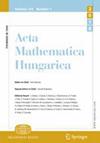伯努利随机图叠加的连通性阈值。2
IF 0.6
3区 数学
Q3 MATHEMATICS
引用次数: 0
摘要
让\(G_1\),…, \(G_m\)是完全图的独立伯努利随机子图\(\mathcal{K}_n\),具有随机大小\(X_1,\dots, X_m\in \{0,1,2,\dots\}\)和边缘密度\(Q_1\),…, \(Q_m\in [0,1]\)。让\(n,m\to+\infty\)为在\(\mathcal{K}_n\)的顶点集上定义的联合\( \bigcup_{i=1}^mG_i\)建立连通性阈值。我们显示$$ \textbf{P} \bigl \{ \bigcup_{i=1}^m G_i \ \hbox{is connected}\ \bigr \}= e^{-e^{\lambda^*_{n,m}}}+o(1) , $$在\(\lambda^{*}_{n,m}= \ln n - \frac{1}{n} \sum\nolimits_{i=1}^{m} \textbf{E} X_{i}(1-(1-Q_i)^{|X_i-1|})\)。本文章由计算机程序翻译,如有差异,请以英文原文为准。
Connectivity threshold for superpositions of Bernoulli random graphs. II
Let \(G_1\), ..., \(G_m\) be independent Bernoulli random subgraphs of the complete graph \(\mathcal{K}_n\) having random sizes \(X_1,\dots, X_m\in \{0,1,2,\dots\}\) and edge densities \(Q_1\), ..., \(Q_m\in [0,1]\). Letting \(n,m\to+\infty\) we establish the connectivity threshold for the union \( \bigcup_{i=1}^mG_i\) defined on the vertex set of \(\mathcal{K}_n\). We show that
$$ \textbf{P} \bigl \{ \bigcup_{i=1}^m G_i \ \hbox{is connected}\ \bigr \}= e^{-e^{\lambda^*_{n,m}}}+o(1) , $$
where \(\lambda^{*}_{n,m}= \ln n - \frac{1}{n} \sum\nolimits_{i=1}^{m} \textbf{E} X_{i}(1-(1-Q_i)^{|X_i-1|})\).
求助全文
通过发布文献求助,成功后即可免费获取论文全文。
去求助
来源期刊
CiteScore
1.50
自引率
11.10%
发文量
77
审稿时长
4-8 weeks
期刊介绍:
Acta Mathematica Hungarica is devoted to publishing research articles of top quality in all areas of pure and applied mathematics as well as in theoretical computer science. The journal is published yearly in three volumes (two issues per volume, in total 6 issues) in both print and electronic formats. Acta Mathematica Hungarica (formerly Acta Mathematica Academiae Scientiarum Hungaricae) was founded in 1950 by the Hungarian Academy of Sciences.

 求助内容:
求助内容: 应助结果提醒方式:
应助结果提醒方式:


